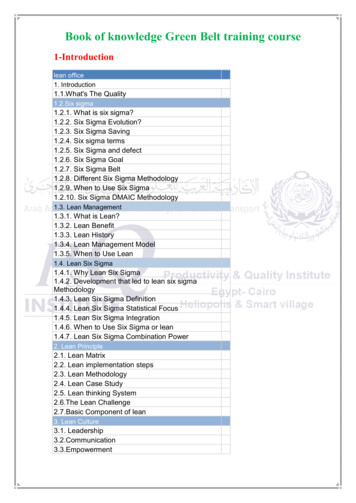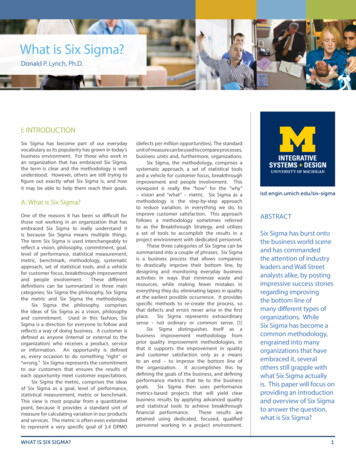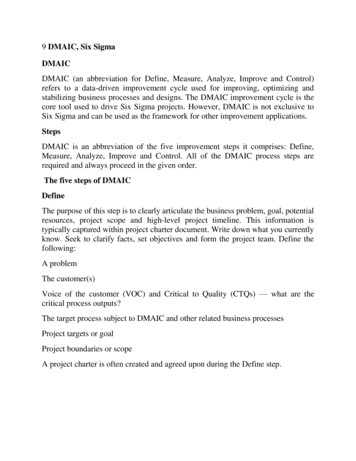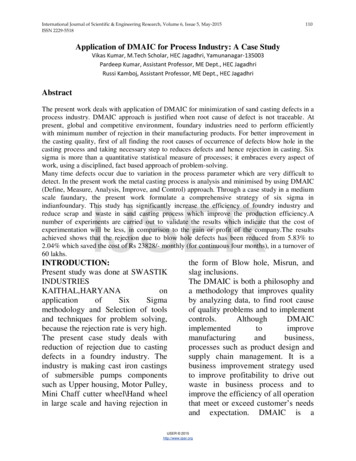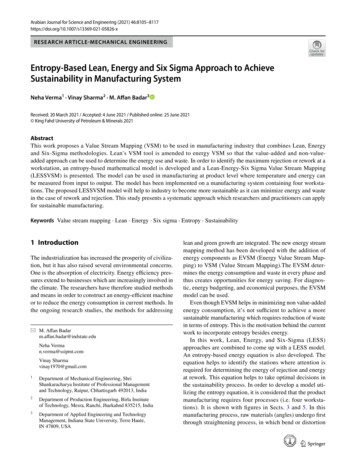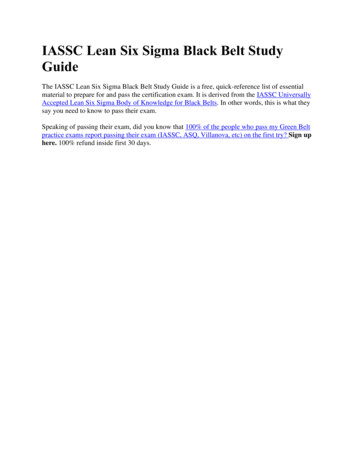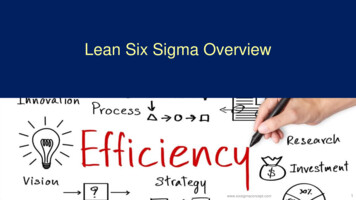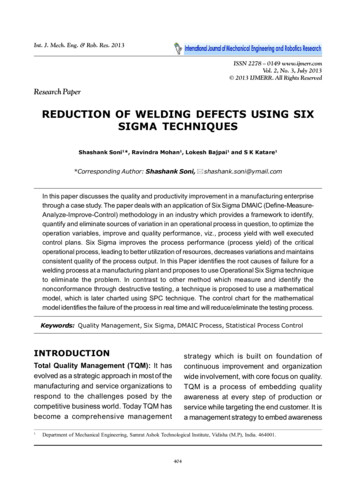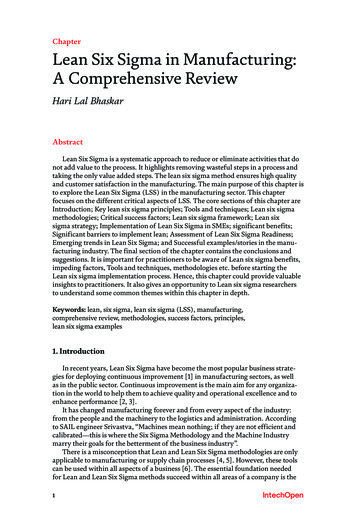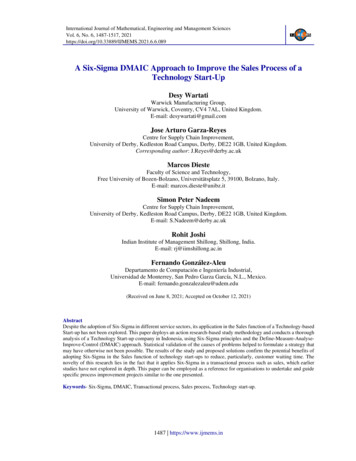
Transcription
International Journal of Mathematical, Engineering and Management SciencesVol. 6, No. 6, 1487-1517, 2021https://doi.org/10.33889/IJMEMS.2021.6.6.089A Six-Sigma DMAIC Approach to Improve the Sales Process of aTechnology Start-UpDesy WartatiWarwick Manufacturing Group,University of Warwick, Coventry, CV4 7AL, United Kingdom.E-mail: desywartati@gmail.comJose Arturo Garza-ReyesCentre for Supply Chain Improvement,University of Derby, Kedleston Road Campus, Derby, DE22 1GB, United Kingdom.Corresponding author: J.Reyes@derby.ac.ukMarcos DiesteFaculty of Science and Technology,Free University of Bozen-Bolzano, Universitätsplatz 5, 39100, Bolzano, Italy.E-mail: marcos.dieste@unibz.itSimon Peter NadeemCentre for Supply Chain Improvement,University of Derby, Kedleston Road Campus, Derby, DE22 1GB, United Kingdom.E-mail: S.Nadeem@derby.ac.ukRohit JoshiIndian Institute of Management Shillong, Shillong, India.E-mail: rj@iimshillong.ac.inFernando González-AleuDepartamento de Computación e Ingeniería Industrial,Universidad de Monterrey, San Pedro Garza García, N.L., Mexico.E-mail: fernando.gonzalezaleu@udem.edu(Received on June 8, 2021; Accepted on October 12, 2021)AbstractDespite the adoption of Six-Sigma in different service sectors, its application in the Sales function of a Technology-basedStart-up has not been explored. This paper deploys an action research-based study methodology and conducts a thoroughanalysis of a Technology Start-up company in Indonesia, using Six-Sigma principles and the Define-Measure-AnalyseImprove-Control (DMAIC) approach. Statistical validation of the causes of problems helped to formulate a strategy thatmay have otherwise not been possible. The results of the study and proposed solutions confirm the potential benefits ofadopting Six-Sigma in the Sales function of technology start-ups to reduce, particularly, customer waiting time. Thenovelty of this research lies in the fact that it applies Six-Sigma in a transactional process such as sales, which earlierstudies have not explored in depth. This paper can be employed as a reference for organisations to undertake and guidespecific process improvement projects similar to the one presented.Keywords- Six-Sigma, DMAIC, Transactional process, Sales process, Technology start-up.1487 https://www.ijmems.in
Wartati et al.: A Six-Sigma DMAIC Approach to Improve the Sales Process of a 1. IntroductionRecent technological revolutions have led to the growth of technology-based start-up companiesaround the world. These ventures in the early stage of development are changing the traditionalconcept of doing business based on technology-driven approaches (Skala, 2019; Lameijer et al.,2021). Apart from the technology’s role in start-up companies, sales and distribution strategies arestill a major part of this sector, thus it is crucial to establish an appropriate sales execution strategyto help these firms bring products or services to market efficiently and effectively (Feinleib, 2011;Gilbert and Davies, 2011). However, developing a viable sales strategy turns out to be a challengefor many start-ups (Skala, 2019). Some start-ups focus aggressively on their sales strategy beforethey have figured out how to make products or services profitable (Feinleib, 2011) while othersoverlook the importance of the sales strategy (Gilbert and Davies, 2011). For the latter case, itsubstantially affects the continuity of sales execution processes, including customer service speedand customer waiting time, which is closely linked to customer satisfaction (Cohan, 2019).During the last decades, different quality management concepts, including Total QualityManagement (TQM), Six-Sigma and lean thinking, have been applied in many different contextsto resolve quality problems (Yadav et al., 2020; Dieste et al., 2021). In particular, the Six-Sigmamethodology can be applied in a wide range of areas, including both manufacturing and serviceindustries (Antony, 2004a; Chiarini, 2013). It was developed to help companies deal with issuessuch as waiting time and improve customer value. Six-Sigma focuses on defects prevention throughthe identification and elimination of errors in business processes by using statistical modelling andempirical methods (Chen and Lyu, 2009; Pyzdek and Keller, 2014). Moreover, it also targets toreduce cycle time and operating expense, improve productivity, and better respond to customerexpectations (Karout and Awasthi, 2017).Since its creation in Motorola in the 1980s (Antony, 2006), Six-Sigma has been widely adopted inthe manufacturing sector (Srinivasan et al., 2016; Ben Ruben et al., 2017) and its application hasbeen successful to reduce waiting time (Muralidharan, 2015) and increase customer satisfaction(Patel, 2017). Recently, the scope of Six-Sigma has expanded/evolved to the service sector andbusiness functions such as sales and marketing (Antony, 2004b; Madhani, 2017; Lameijer et al.,2021). Thus, the suitability of the Six-Sigma application to improve sales activities in general andreducing/eliminating the causes of waiting time in sales processes is relevant as it provides asystematic solution for such quality problems. According to Antony et al. (2020) research in SixSigma in SMEs and start-up enterprises should also be expanded as its implementation remainsvery challenging for the firm, but would be rewarding if implemented properly.In this scope and by following an action research-based approach, this paper aims to achieve thefollowing research objectives: Analyse the current state of the literature regarding the application of Six-Sigma in salesprocesses and Start-up companies.Deploy Six-Sigma principles and tools to improve the sales process of a Technology Start-upcompany.Utilise the DMAIC improvement cycle as the core problem-solving approach to improve thesales process of a Technology Start-up.To achieve these objectives this research first reviews previous studies about Six-Sigma’sapplication in the marketing and sales functions. Then, an action research-based study is deployed1488 Vol. 6, No. 6, 2021
Wartati et al.: A Six-Sigma DMAIC Approach to Improve the Sales Process of a within a Technology Start-up based in Indonesia that aimed to improve its business performance,earn a considerable market valuation, and compete on an international level through efficient salesactivities and minimising customer waiting time to enhance customer satisfaction. These issueswere identified as critical by the company analysed.This research and its contribution are novel as to the best of the authors’ knowledge no in-depthstudy has been previously conducted regarding the application of Six-Sigma in the sales process ofTechnology related Start-ups. Thus, this research fills this gap by using Six-Sigma for businessimprovement in technology start-up companies by expanding the spectrum of Six-Sigmaimplementation in the service sector, specifically in the Sales function of Technology-based Startup companies. The analysis confirms that Six-Sigma techniques can be effectively utilised to solveproblems in the Sales function. Additionally, this study can trigger interest among other technologystart-ups to adopt statistical modelling methods such as Six-Sigma for business improvement.2. Literature ReviewSix-Sigma is described as a data-driven approach to improve business processes (Alblooshi et al.,2020) by reducing variability (Patel, 2017). Cudney and Agustiady (2017) state that the sigma levelrefers to the process capability of a company that “represents the number of standard deviationsbetween the centre of a process and the closest specification limit”. In other words, it is principallya strategy that aims to reduce defects and errors in all processes that are critical to the customer(Garza-Reyes et al., 2016).Many companies have utilised Six-Sigma to drive improvements and strive for excellence in qualitystandards and customer satisfaction (Alkunsol et al., 2019), specifically in manufacturing sectorsfor reducing defects (Ben Ruben et al., 2017). Its adoption has now evolved further in servicesectors (Shamsuzzaman et al., 2018) and the medical industry (Sunder et al., 2020). Although theconcept of Six-Sigma was developed/adopted, initially, in the manufacturing sector, it is essentiallya process improvement approach that can be used in diverse business areas (Jirasukprasert et al.,2014). These could include improving on-time delivery (Mishra and Rane, 2019), reducing cycletime for hiring and training new employees (Mehrjerdi, 2013), reducing the complaint resolutiontime across information technology organisations (Gijo et al., 2019), improving the average orderfulfilment lead time for sales orders (Shamsuzzaman et al., 2018), or improving software quality(Karout and Awasthi, 2017).The most important concept of Six-Sigma is a structured problem-solving approach that contains afive-phase improvement cycle, i.e. Define, Measure, Analyse, Improve, and Control (Garza-Reyeset al., 2016; Madhani, 2017). Utilising DMAIC to systematically approach/tackle problems helpsto identify/resolve the root causes (Karout and Awasthi, 2017; Garza-Reyes et al., 2018) through aset of tools and techniques in each stage (Shamsuzzaman et al., 2018).Historically, Six-Sigma has been prevalent in the manufacturing sector (Antony, 2006) and recentlyits adoption in the service sector has been also observed (Lameijer et al., 2021). However, itsapplication in sales processes has not received much attention (Salzarulo et al., 2012; Antony et al.,2016; Sangabriel-Guillen et al., 2017) since there are limiting factors that can reduce its spread (e.g.difficulty in gathering and measuring data) (Chakrabarty and Tan, 2007). This paper addresses thisgap in the scholarly literature. Many scholars question the ability of Six-Sigma to enhance salesand/or marketing processes. Pestorius (2007) and Madhani (2017) argue that there is a hugepotential in applications of Six-Sigma, although transactional processes such as sales are considered1489 Vol. 6, No. 6, 2021
Wartati et al.: A Six-Sigma DMAIC Approach to Improve the Sales Process of a to be one of the most challenging areas for Six-Sigma implementation. They argue that thischallenge exists due to the difficulty to identify appropriate projects as there are fewer processvariables that can be controlled. Salzarulo et al. (2012) contend that Six-Sigma’s application in themarketing activities of a basketball sport event boosted the attendance number. Moreover, Oliya etal. (2012) found that Six-Sigma could assist in the improvement of a bank’s sales and marketingprocess. Likewise, the adoption of Six-Sigma to increase operating and financial performance, inSwink and Jacobs' (2012) study, was incidentally associated with the improvement in sales growth.Furthermore, the study conducted by Lee (2014) also confirms the usefulness of Six-Sigma toimprove marketing and control the sales of a service company. Similarly, Antony et al. (2016)demonstrated that Six Sigma’s application in Indian companies brought progressive improvementsin sales, marketing, finance and other transaction-related processes. Sangabriel-Guillen et al. (2017)exhibited Six-Sigma projects as a value driver for sales and marketing in the soft drinks bottlingindustry. Scholarly research with empirical evidence suggests the potential of Six-Sigma utilisationin sales and/or marketing.Technological advancement is immersed in almost all types of businesses and has transformedevery aspect, including the way companies operate and carry out business activities (Nadeem et al.,2019). Such growth in technology and its adoption at a wide scale has led to theemergence/development of new start-ups, specifically operating in the technology sector. Suchcompanies perform an important part in driving innovation (Hathaway, 2013). Nevertheless, likeany other type of firm, Technology-based Startups also face several challenges as they also havelimited resources, especially limited funds and budgets (Skala, 2019). Constrained with thelimitations, start-ups must remain creative and innovative to both develop their specificproduct/services (Gilbert and Davies, 2011) and a strategy to enter the market with a unique anddistinct approach. Due to the product/service being the major deliverables of the business, the focusremains on ensuring creativity and innovation in that and thus preventing them from consideringthe importance of how to deliver the products or services to market more efficiently and effectively.In other words, the majority of start-ups fail to reflect on their sales execution strategy to delivervalue for customers as they focus more on being creative/innovative in their products/services. Thisis one of the many aspects where Six-Sigma principles and tools can be useful for start-upcompanies to improve their sales and marketing functions (Madhani, 2017; Lameijer et al., 2021).The correct adoption and implementation of Six-Sigma could enhance quality standards andcustomer satisfaction through the sales function of start-ups, as they need economical solutions forthe achievement of superior quality to the customer (Patel, 2017). However, implementing SixSigma is still a huge challenge for start-ups and SMEs, but the benefits can be many. Antony et al.(2020) identify this emerging trend as a novel path for further research.To sum up, previous studies largely overlooked (a) the implementation of Six-Sigma principles andtools to improve sales processes; and (b) the deployment of the DMAIC approach in a TechnologyStart-up context. These are research gaps that have not been extensively addressed in the Six-Sigmaacademic literature.3. MethodologyMultiple Six-Sigma tools were utilised in the present research under the five phases of the DMAICapproach to investigate errors/mistakes in the process and to offer potential solutions to reducewaiting time within the context of a technology Start-up organisation, see Section 4. Similar to theworks conducted by Krueger et al. (2014), Zhang et al. (2015), Garza-Reyes et al. (2016),1490 Vol. 6, No. 6, 2021
Wartati et al.: A Six-Sigma DMAIC Approach to Improve the Sales Process of a Swarnakar and Vinodh (2016), and Noori and Latifi (2018), this study followed the traditionalDMAIC structure (see Figure 1).Once the DMAIC framework was designed, the Six-Sigma methodology was applied in the firmunder analysis. This led to empirical research for which the most appropriate researchmethodologies are case study or action research (Shadish et al., 2002). Recently, the use of a singlecase study has been well accepted as a valid research approach (Garza-Reyes et al., 2016).However, the action research approach is considered as a more valid research method, especiallywhen conducting continuous improvement projects (Dey et al., 2015; Gutierrez et al., 2015; GarzaReyes et al., 2016).This study required the researchers to closely manage and track the deployment of the proposedSix-Sigma and DMAIC methods and the improvement project. Action research is the appropriateresearch method for investigating and generating practical solutions with the participation ofrepresentatives from the case companies in the research process (Prashar, 2020). The participationof the researchers was essential to lead and support such implementation and management(Gutierrez et al., 2015). Thus, action research was considered the most suitable methodology tocarry out this study. The action research approach also guaranteed that the application challengesof the Six-Sigma framework were overcome with direct help from the researchers (Gutierrez et al.,2015). For this study, the action research approach proved to be a valuable method to test the SixSigma implementation and draw conclusions regarding its effectiveness (Garza-Reyes et al., 2016),while analysing the root causes of the waiting time in the onboarding stage (i.e. set-up the merchantson the company’s platform) in the studied sales process.Six SigmaMethodologyMain activitiesToolsDefineDefine the current process that needsimprovement based on voice ofcustomersSIPOC; Operational definition;Voice of customers; Critical tosatisfactions; Project charterMeasureCollect data from the current processto understand the baselineperformance of the processData collection planNormality testProcess capabilityAnalyseIdentify potential causes of theproblem and validate them to obtainthe root causesProcess flow chartCause-and-effect diagramGemba investigationHypothesis testImproveGenerate solutions and formulate animplementation roadmap based on theidentified solutionsPrioritisation matrixImplementation roadmapAction stepsControlPropose a set of control mechanism tosustain the improvement changesPoka-yokeStandard operational procedureControl chartFigure 1. DMAIC framework and Six-Sigma tools.1491 Vol. 6, No. 6, 2021
Wartati et al.: A Six-Sigma DMAIC Approach to Improve the Sales Process of a As part of the action research approach, the DMAIC methodology was employed simultaneouslywith several Six-Sigma tools as illustrated in Figure 1. This practical approach provides a structuredmethod to solve a problem and achieve business improvement (Madhani, 2017). Furthermore, thismethodology is also essential to analyse variation in waiting time (Gijo et al., 2014), which is inline with the concern of this study.4. Overview of the Organisation’s BackgroundThe company selected for the study is a Technology Start-up (hereafter referred to as XYZCompany) with its headquarters based in Indonesia. The XYZ Company was established in 2010,offering on-demand transport for customers. In 2015, the company extended its business servicesby introducing a mobile application platform. With continuous growth and expansion, presentlythe company operates in over 50 cities across South-East Asia. It provides its services through adigital application, offering more than ten products of on-demand services, including motorcycletaxis, food delivery services, digital payments, shopping, delivering items, and other additionalservices. Among all the services, ordering and delivering food has become the most popular. Themain clients of this product are restaurants that want to become a merchant and offer food deliveryservices using the platform of the XYZ Company. This merchant is called “partner” and onceregistered on the mobile application of XYZ Company, they can be easily found by millions ofcustomers. Afterwards, customers order foods from registered restaurants using the company’sapps.The scope of this research concentrated on analysing the food delivery service within the regionalpartners based in a certain region of Indonesia. This referred to the requirement of the companyitself and also the reports of the problems that their merchants were facing in waiting time withinthe onboarding stage (one part of the sales process), which delayed the overall sales activities.4.1 The Sales ProcessOne of the most critical steps towards a profitable and sustainable food delivery business isacquiring more partners, which can be achieved by increasing sales activity (Upadhyay et al.,2019). In this regard, a sales team plays a vital role as they are responsible for bringing in newclients and maintaining good relationships with them. To increase sales activity, a significant stepis to ensure the efficiency of the sales process so the company can shorten the sales cycle andaccelerate time to revenue (Hase and Busch, 2018).Company XYZ had the following three major stages in the sales process: Prospecting: this initial step involves the identification of potential buyers (merchants), thenshortlisting the list to convert them from potential customers to current customers. This stepincludes developing a database of merchants and communicating with them to build rapport. Onboarding: afterwards, the sales team continue to work with the merchants to get them setup on the company’s platform. The merchants fill in a form sent to their email, or they registerdirectly in the office. Thereafter, the contract documents are signed with the merchant. Then,all the information is forwarded to the sales support team for final checks and content divisionas a requirement for the platform setting. The sales team perform the merchants' onboardingmanually and manage their data via spreadsheets in Microsoft Excel and Google Sheets. Following-up: as a final step, the merchants will be informed about the account activation. Thesales team still stay in contact with the merchants and provides after-sales support.1492 Vol. 6, No. 6, 2021
Wartati et al.: A Six-Sigma DMAIC Approach to Improve the Sales Process of a 4.2 The Problem Faced by XYZ CompanyThe company’s records and historical data indicated that the firm was struggling with waiting timeproblems in the onboarding stage of the sales process. In this case, the new merchant applicationranged from 30-50 applications/day. However, since the sales team also performed the onboardingmanually, the waiting time for getting the contract process completed was higher than normal. Thisproblem was critical not only for sales efficiency but also for other divisions in the firm, such asthe sales support and content division, which needed inputs from the onboarding stage to designand set up the platform so the merchant could start their business with Company XYZ. Therefore,the onboarding stage was selected for Six-Sigma application.5. DMAIC Cycle ApplicationAs discussed in Section 4.2, the merchant’s waiting time at this stage had been a critical issue forsales efficiency. According to the firm, this was one of the main causes of the decrease in customersatisfaction. In this section, a Six-Sigma problem-solving methodology, DMAIC is deployed toidentify and reduce/eliminate the causes that contributed to increased waiting time for the merchant.This section presents the five phases of the DMAIC methodology adopted for this research (seeFigure 1), elucidating a detailed analysis under each phase.5.1 The Define PhaseIn this phase, the first step was to form the project team that would carry out all the steps under theDMAIC methodology. Once the project team was formed, they then embarked on scoping theproject, identifying improvement opportunities, as well as clarifying the project outlines and goals(Arafeh et al., 2014; Karout and Awasthi, 2017).5.1.1 Team FormationA team of three people was formed, comprising a senior account executive (responsible for theentire sales process), an experienced front-line sales staff (responsible for the onboarding stage),and an improvement project facilitator. The facilitator served as the project leader to bring SixSigma expertise/improvements. The two employees had basic knowledge about Six-Sigma andwere familiar with statistical tools.The top management of Company XYZ showed a positive involvement in the project, which iscrucial for the success of improvement initiatives (Shamsuzzaman et al., 2018) and can multiplythe positive effects at all levels in the organisations (Gijo et al., 2019).5.1.2 Project ScopingThe project scoping defines the boundaries and helps concentrate the efforts on the core purpose toadequately achieve the desired results (Patel, 2017). Since the company received a series ofcomplaints from dissatisfied merchants about waiting time in the onboarding process, the researchscope was limited only to the onboarding stage of the sales process. The onboarding stage includedthe activities of issuing registration numbers, calling merchants as per turn, entering data into thesystem, creating a contract, and placing orders. Moreover, addressing the waiting time issues wasof strategic importance for the company as it directly impacted the efficiency of the overall salesactivities to expand market share and generate more profit.1493 Vol. 6, No. 6, 2021
Wartati et al.: A Six-Sigma DMAIC Approach to Improve the Sales Process of a 5.1.3 SIPOC (Supplier-Input-Process-Output-Customer) DiagramTo obtain a detailed understanding of the process/steps involved, and their flow, to achieve thedesired outputs, it is vital to have a clear understanding of the big picture of the process (Pyzdekand Keller, 2014). For this purpose, a SIPOC (Supplier–Input–Process–Output–Customer) diagramwas created, as illustrated in Figure 2, to create a high-level map of a process that helps in definingboundaries and identifying processes requiring improvements (Gijo and Scaria, 2014).SuppliersMerchantsSales teamInputsProcessesRegistrationformFill documentsOutletdocumentsSubmit outletdocumentsVerifyMerchant’sdataVerify formsandmerchant’sdocumentsInputMerchant’sdata in dedSales TeamCreatecontractdocumentsMerchantsContractSign thecontractContract signedMerchantsSales teamMarchant’sorderPlace orderOrder enteredSalessupportteamFigure 2. SIPOC diagram for onboarding stage in the sales process.1494 Vol. 6, No. 6, 2021
Wartati et al.: A Six-Sigma DMAIC Approach to Improve the Sales Process of a As seen in Figure 2, the onboarding stage starts with the front-line staff issuing a registrationform/number for merchants. Merchants then fill in the registration form and submit with the identitydocuments, as well as outlet documents such as food photos, menu details, and menu price. Thesubmitted documents are checked by staff and if all the information provided is adequate, theinformation is then entered into the system. Following this, a contract is created and given to therelated merchant. Finally, the process ends when the merchant signs the contract, and the order isforwarded to the sales support and content division for further processing.5.1.4 Operational Definition of Waiting TimeTo investigate the merchant’s waiting time issue, it was essential to develop an operationaldefinition for the waiting time. The project team concluded that the time from when the merchantfills in the registration form until the time the merchant signs the contract would be defined as‘merchant waiting time in the onboarding stage’. Consequently, the time when the staff issued theregistration number and placed the order to the corresponding division were excluded from waitingtime.5.1.5 Voice of the CustomerIt is essential to understand customer’s needs and perceptions of value to deliver the rightproducts/services (Patel, 2017). For this purpose, Voice of the Customer (VOC) expressing theirrequirements at all levels (Cudney and Agustiady, 2017) were examined to support theimprovement initiatives. This VOC should be translated into specific elements within the process,so the company could identify areas to be improved based on the customers’ point of view(Chakraborty and Tan, 2012). These values were indicated as critical to satisfaction (CTS) and hada direct effect on the process output.The VOC was formulated based on customers’ complaints regarding the onboarding process, whichwere obtained through phone calls, emails, and/or direct visits to them. An increase in customercomplaints for the last three months further affirmed the lack of efficiency and effectiveness of thisprocess. Since the complete information regarding the customer complaints history wasconfidential information, the selected VOC used in this project was derived from the results ofmeetings with staff which had been approved by the Regional Sales Manager. Next, the VOC wastransformed into CTS.The merchant’s waiting time indicated the value in the process that needed to be improvedaccording to the customers’ standpoint. As the waiting time could impact the process output, whichwas the contract, it was considered as CTS and measured by the time from filling in the registrationform until signing the contract, which was specified to be 20 minutes. Defect definition wasdescribed as the waiting time to be more than 20 minutes.5.1.6 Project GoalAfter identifying the problem and defining the CTS, the project team, in consultation with theRegional Sales Manager, formulated the project’s goal, which was ‘to reduce the merchant waitingtime in the onboarding stage to less than 20 minutes’. The 20 minutes target was set based on therequirement of the manager in the company. Additionally, since waiting time problems were alsothe result of unclear procedures, another goal was ‘to create a standardised, documented, andrepeatable onboarding process’.1495 Vol. 6, No. 6, 2021
Wartati et al.: A Six-Sigma DMAIC Approach to Improve the Sales Process of a 5.1.7 Project CharterFinally, a project charter was created to capture and summarise all necessary details of the project(Gijo et al., 2014), to constitute the documented conclusion of the Define phase. The project charterpresented in Table 1 was used as a guide for the team.Table 1. Project charter.Project TitleBusiness caseProblemstatementProject scopeProject goalsPrimary metricCTSProject teamExpectedbenefitReducing waiting time in the onboarding stage in the sales process The onboarding stage is very critical to sales efficiency. Early onboarding process means faster set up of the platform for the merchants. Performing a streamlined onboarding process leads to higher customer satisfaction and increases salesactivities that affect the business bottom line.Customers perceive that they wait too long in the onboarding stage to get the contract. This indicates that thereis a lack of service in this process which results in an increase in customer complaints for the past three months.The onboarding stage in the sales processTo reduce waiting time in the onboarding stage to less than 20 minutesMerchant waiting time (minutes)Merchant waiting time in the onboarding stage(i)A senior account executive(ii)An experienced front-line staff(iii)The researcher Reduction of waiting time in the sales process Reduction of merchant complaints Improved customer satisfaction5.2 The Measure PhaseThe main
al. (2012) found that Six-Sigma could assist in the improvement of a bank’s sales and marketing process. Likewise, the adoption of Six-Sigma to increase operating and financial performance, in Swink and Jacobs' (2012) study
